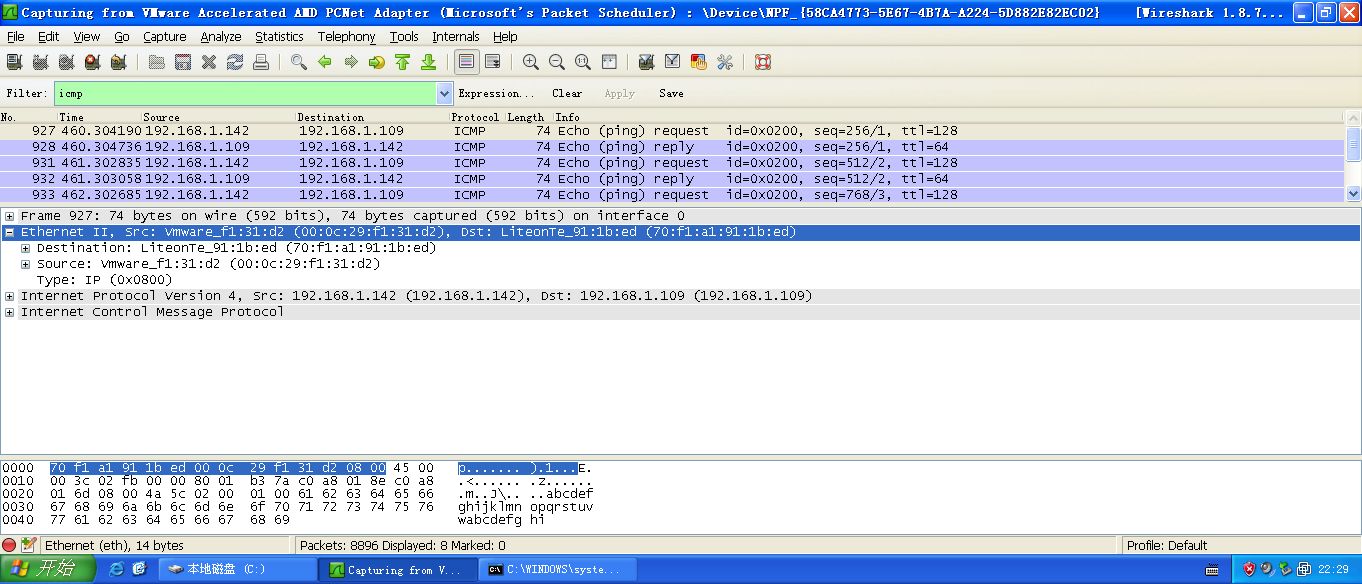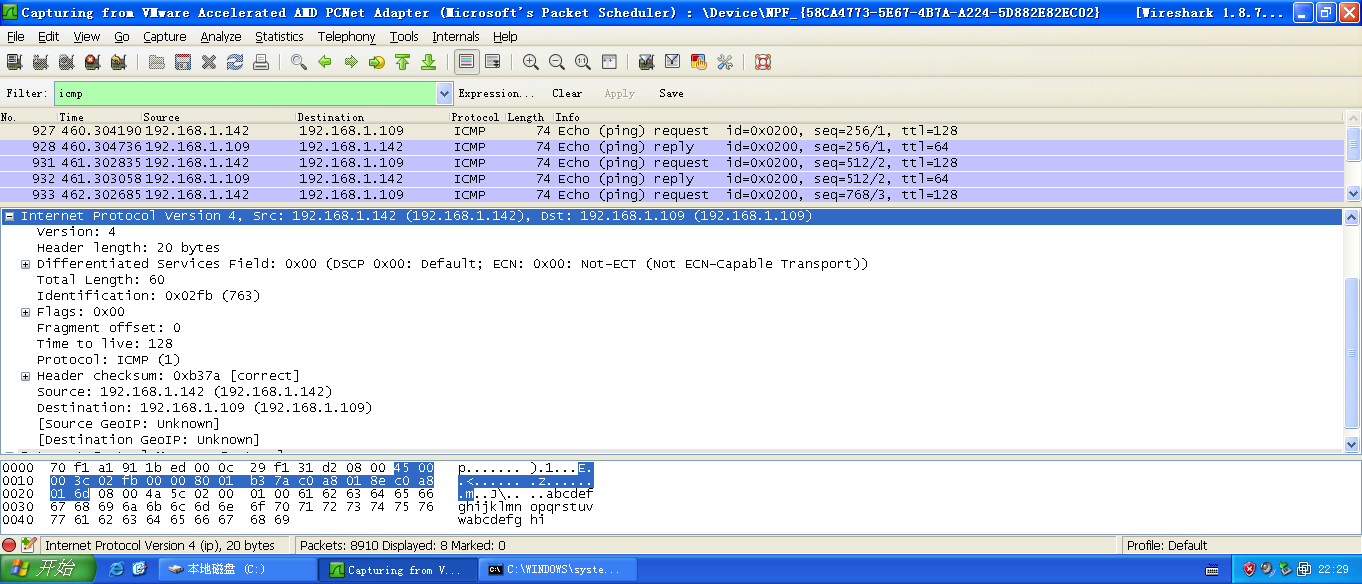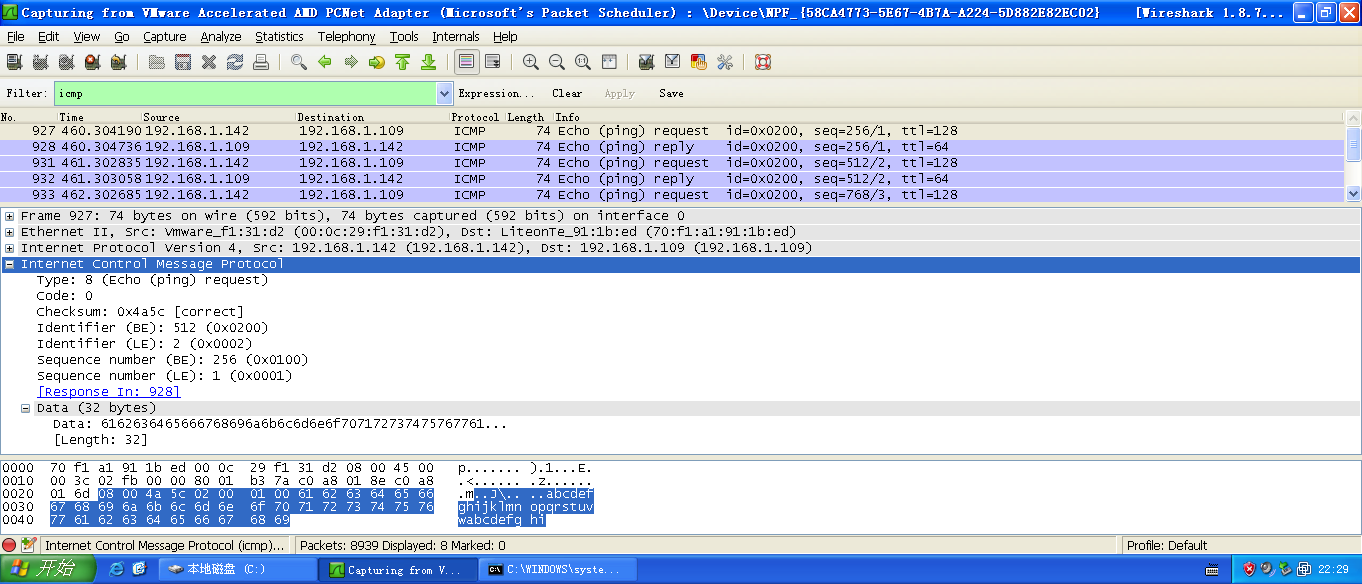http://en.wikipedia.org/wiki/Internet_Control_Message_Protocol
ICMP segment structure [edit]
Header [edit]
The ICMP header starts after the IPv4 header and is identified by protocol number '1'. All ICMP packets will have an 8-byte header and variable-sized data section. The first 4 bytes of the header will be consistent. The first byte is for the ICMP type. The second byte is for the ICMP code. The third and fourth bytes are a checksum of the entire ICMP message. The contents of the remaining 4 bytes of the header will vary based on the ICMP type and code.[1]
ICMP error messages contain a data section that includes the entire IP header plus the first 8 bytes of data from the IP packet that caused the error message. The ICMP packet is then encapsulated in a new IP packet.[1]
| Bits | 0–7 | 8–15 | 16–23 | 24–31 |
|---|---|---|---|---|
| 0 | Type | Code | Checksum | |
| 32 | Rest of Header | |||
- Type – ICMP type as specified below.
- Code – Subtype to the given type.
- Checksum – Error checking data. Calculated from the ICMP header+data, with value 0 for this field. The checksum algorithm is specified in RFC 1071.
- Rest of Header – Four byte field. Will vary based on the ICMP type and code.
Control messages [edit]
| Type | Code | Description |
|---|---|---|
| 0 – Echo Reply[3]:14 | 0 | Echo reply (used to ping) |
| 1 and 2 | Reserved | |
| 3 – Destination Unreachable[3]:4 | 0 | Destination network unreachable |
| 1 | Destination host unreachable | |
| 2 | Destination protocol unreachable | |
| 3 | Destination port unreachable | |
| 4 | Fragmentation required, and DF flag set | |
| 5 | Source route failed | |
| 6 | Destination network unknown | |
| 7 | Destination host unknown | |
| 8 | Source host isolated | |
| 9 | Network administratively prohibited | |
| 10 | Host administratively prohibited | |
| 11 | Network unreachable for TOS | |
| 12 | Host unreachable for TOS | |
| 13 | Communication administratively prohibited | |
| 14 | Host Precedence Violation | |
| 15 | Precedence cutoff in effect | |
| 4 – Source Quench | 0 | Source quench (congestion control) |
| 5 – Redirect Message | 0 | Redirect Datagram for the Network |
| 1 | Redirect Datagram for the Host | |
| 2 | Redirect Datagram for the TOS & network | |
| 3 | Redirect Datagram for the TOS & host | |
| 6 | Alternate Host Address | |
| 7 | Reserved | |
| 8 – Echo Request | 0 | Echo request (used to ping) |
| 9 – Router Advertisement | 0 | Router Advertisement |
| 10 – Router Solicitation | 0 | Router discovery/selection/solicitation |
| 11 – Time Exceeded[3]:6 | 0 | TTL expired in transit |
| 1 | Fragment reassembly time exceeded | |
| 12 – Parameter Problem: Bad IP header | 0 | Pointer indicates the error |
| 1 | Missing a required option | |
| 2 | Bad length | |
| 13 – Timestamp | 0 | Timestamp |
| 14 – Timestamp Reply | 0 | Timestamp reply |
| 15 – Information Request | 0 | Information Request |
| 16 – Information Reply | 0 | Information Reply |
| 17 – Address Mask Request | 0 | Address Mask Request |
| 18 – Address Mask Reply | 0 | Address Mask Reply |
| 19 | Reserved for security | |
| 20 through 29 | Reserved for robustness experiment | |
| 30 – Traceroute | 0 | Information Request |
| 31 | Datagram Conversion Error | |
| 32 | Mobile Host Redirect | |
| 33 | Where-Are-You (originally meant for IPv6) | |
| 34 | Here-I-Am (originally meant for IPv6) | |
| 35 | Mobile Registration Request | |
| 36 | Mobile Registration Reply | |
| 37 | Domain Name Request | |
| 38 | Domain Name Reply | |
| 39 | SKIP Algorithm Discovery Protocol, Simple Key-Management for Internet Protocol | |
| 40 | Photuris, Security failures | |
| 41 | ICMP for experimental mobility protocols such as Seamoby [RFC4065] | |
| 42 through 255 | Reserved |
Source quench [edit]
Source Quench requests that the sender decrease the rate of messages sent to a router or host. This message may be generated if a router or host does not have sufficient buffer space to process the request, or may occur if the router or host buffer is approaching its limit.
Data is sent at a very high speed from a host or from several hosts at the same time to a particular router on a network. Although a router has buffering capabilities, the buffering is limited to within a specified range. The router cannot queue any more data than the capacity of the limited buffering space. Thus if the queue gets filled up, incoming data is discarded until the queue is no longer full. But as no acknowledgement mechanism is present in the network layer, the client does not know whether the data has reached the destination successfully. Hence some remedial measures should be taken by the network layer to avoid these kind of situations. These measures are referred to as source quench. In a source quench mechanism, the router sees that the incoming data rate is much faster than the outgoing data rate, and sends an ICMP message to the clients, informing them that they should slow down their data transfer speeds or wait for a certain amount of time before attempting to send more data. When a client receives this message, it will automatically slow down the outgoing data rate or wait for a sufficient amount of time, which enables the router to empty the queue. Thus the source quench ICMP message acts as flow control in the network layer.
| 00 | 01 | 02 | 03 | 04 | 05 | 06 | 07 | 08 | 09 | 10 | 11 | 12 | 13 | 14 | 15 | 16 | 17 | 18 | 19 | 20 | 21 | 22 | 23 | 24 | 25 | 26 | 27 | 28 | 29 | 30 | 31 |
|---|---|---|---|---|---|---|---|---|---|---|---|---|---|---|---|---|---|---|---|---|---|---|---|---|---|---|---|---|---|---|---|
| Type = 4 | Code = 0 | Header checksum | |||||||||||||||||||||||||||||
| unused | |||||||||||||||||||||||||||||||
| IP header and first 8 bytes of original datagram's data | |||||||||||||||||||||||||||||||
Where:
- Type must be set to 4
- Code must be set to 0
- IP header and additional data is used by the sender to match the reply with the associated request
Redirect [edit]
Redirect requests data packets be sent on an alternative route. ICMP Redirect is a mechanism for routers to convey routing information to hosts. The message informs a host to update its routing information (to send packets on an alternate route). If a host tries to send data through a router (R1) and R1 sends the data on another router (R2) and a direct path from the host to R2 is available (that is, the host and R2 are on the same Ethernet segment), then R1 will send a redirect message to inform the host that the best route for the destination is via R2. The host should then send packets for the destination directly to R2. The router will still send the original datagram to the intended destination. However, if the datagram contains routing information, this message will not be sent even if a better route is available. RFC1122 states that redirects should only be sent by gateways and should not be sent by Internet hosts.
| 00 | 01 | 02 | 03 | 04 | 05 | 06 | 07 | 08 | 09 | 10 | 11 | 12 | 13 | 14 | 15 | 16 | 17 | 18 | 19 | 20 | 21 | 22 | 23 | 24 | 25 | 26 | 27 | 28 | 29 | 30 | 31 |
|---|---|---|---|---|---|---|---|---|---|---|---|---|---|---|---|---|---|---|---|---|---|---|---|---|---|---|---|---|---|---|---|
| Type = 5 | Code | Header checksum | |||||||||||||||||||||||||||||
| IP address | |||||||||||||||||||||||||||||||
| IP header and first 8 bytes of original datagram's data | |||||||||||||||||||||||||||||||
Where:
- Type must be set to 5.
- Code specifies the reason for the redirection, may be one of the following:
-
-
Code Description 0 Redirect for Network 1 Redirect for Host 2 Redirect for Type of Service and Network 3 Redirect for Type of Service and Host
-
- IP address is the 32-bit address of the gateway to which the redirection should be sent.
- IP header and additional data is included to allow the host to match the reply with the request that caused the redirection reply.
Time exceeded [edit]
Time Exceeded is generated by a gateway to inform the source of a discarded datagram due to the time to live field reaching zero. A time exceeded message may also be sent by a host if it fails to reassemble a fragmented datagram within its time limit.
Time exceeded messages are used by the traceroute utility to identify gateways on the path between two hosts.
| 00 | 01 | 02 | 03 | 04 | 05 | 06 | 07 | 08 | 09 | 10 | 11 | 12 | 13 | 14 | 15 | 16 | 17 | 18 | 19 | 20 | 21 | 22 | 23 | 24 | 25 | 26 | 27 | 28 | 29 | 30 | 31 |
|---|---|---|---|---|---|---|---|---|---|---|---|---|---|---|---|---|---|---|---|---|---|---|---|---|---|---|---|---|---|---|---|
| Type = 11 | Code | Header checksum | |||||||||||||||||||||||||||||
| unused | |||||||||||||||||||||||||||||||
| IP header and first 8 bytes of original datagram's data | |||||||||||||||||||||||||||||||
Where:
- Type must be set to 11
- Code specifies the reason for the time exceeded message, include the following:
-
-
Code Description 0 Time-to-live exceeded in transit. 1 Fragment reassembly time exceeded.
-
- IP header and first 64 bits of the original payload are used by the source host to match the time exceeded message to the discarded datagram. For higher level protocols such as UDP and TCP the 64 bit payload will include the source and destination ports of the discarded packet.
Timestamp [edit]
Timestamp is used for time synchronization. It consists of the originating timestamp.
| 00 | 01 | 02 | 03 | 04 | 05 | 06 | 07 | 08 | 09 | 10 | 11 | 12 | 13 | 14 | 15 | 16 | 17 | 18 | 19 | 20 | 21 | 22 | 23 | 24 | 25 | 26 | 27 | 28 | 29 | 30 | 31 |
|---|---|---|---|---|---|---|---|---|---|---|---|---|---|---|---|---|---|---|---|---|---|---|---|---|---|---|---|---|---|---|---|
| Type = 13 | Code = 0 | Header checksum | |||||||||||||||||||||||||||||
| Identifier | Sequence number | ||||||||||||||||||||||||||||||
| Originate timestamp | |||||||||||||||||||||||||||||||
Where:
- Type must be set to 13
- Code must be set to 0
- Identifier and Sequence Number can be used by the client to match the timestamp reply with the timestamp request.
- Originate timestamp is the number of milliseconds since midnight Universal Time (UT). If a UT reference is not available the most-significant bit can be set to indicate a non-standard time value.
Timestamp reply [edit]
Timestamp Reply replies to a Timestamp message. It consists of the originating timestamp sent by the sender of the Timestamp as well as a receive timestamp and a transmit timestamp.
| 00 | 01 | 02 | 03 | 04 | 05 | 06 | 07 | 08 | 09 | 10 | 11 | 12 | 13 | 14 | 15 | 16 | 17 | 18 | 19 | 20 | 21 | 22 | 23 | 24 | 25 | 26 | 27 | 28 | 29 | 30 | 31 |
|---|---|---|---|---|---|---|---|---|---|---|---|---|---|---|---|---|---|---|---|---|---|---|---|---|---|---|---|---|---|---|---|
| Type = 14 | Code = 0 | Header checksum | |||||||||||||||||||||||||||||
| Identifier | Sequence number | ||||||||||||||||||||||||||||||
| Originate timestamp | |||||||||||||||||||||||||||||||
| Receive timestamp | |||||||||||||||||||||||||||||||
| Transmit timestamp | |||||||||||||||||||||||||||||||
Where:
- Type must be set to 14
- Code must be set to 0
- Identifier and Sequence number can be used by the client to match the reply with the request that caused the reply.
- Originate timestamp is the time the sender last touched the message before sending it.
- Receive timestamp is the time the echoer first touched it on receipt.
- Transmit timestamp is the time the echoer last touched the message on sending it.
- All timestamps are in units of milliseconds since midnight UT. If the time is not available in milliseconds or cannot be provided with respect to midnight UT then any time can be inserted in a timestamp provided the high order bit of the timestamp is also set to indicate this non-standard value.
Address mask request [edit]
Address mask request is normally sent by a host to a router in order to obtain an appropriate subnet mask.
Recipients should reply to this message with an Address mask reply message.
| 00 | 01 | 02 | 03 | 04 | 05 | 06 | 07 | 08 | 09 | 10 | 11 | 12 | 13 | 14 | 15 | 16 | 17 | 18 | 19 | 20 | 21 | 22 | 23 | 24 | 25 | 26 | 27 | 28 | 29 | 30 | 31 |
|---|---|---|---|---|---|---|---|---|---|---|---|---|---|---|---|---|---|---|---|---|---|---|---|---|---|---|---|---|---|---|---|
| Type = 17 | Code = 0 | Header checksum | |||||||||||||||||||||||||||||
| Identifier | Sequence number | ||||||||||||||||||||||||||||||
| Address mask | |||||||||||||||||||||||||||||||
Where:
- Type must be set to 17
- Code must be set to 0
- Address mask can be set to 0
ICMP Address Mask Request may be used as a part of reconnaissance attack to gather information on the target network, therefore ICMP Address Mask Reply is disabled by default on Cisco IOS.[6]
Address mask reply [edit]
Address mask reply is used to reply to an address mask request message with an appropriate subnet mask.
| 00 | 01 | 02 | 03 | 04 | 05 | 06 | 07 | 08 | 09 | 10 | 11 | 12 | 13 | 14 | 15 | 16 | 17 | 18 | 19 | 20 | 21 | 22 | 23 | 24 | 25 | 26 | 27 | 28 | 29 | 30 | 31 |
|---|---|---|---|---|---|---|---|---|---|---|---|---|---|---|---|---|---|---|---|---|---|---|---|---|---|---|---|---|---|---|---|
| Type = 18 | Code = 0 | Header checksum | |||||||||||||||||||||||||||||
| Identifier | Sequence number | ||||||||||||||||||||||||||||||
| Address mask | |||||||||||||||||||||||||||||||
Where:
- Type must be set to 18
- Code must be set to 0
- Address mask should be set to the subnet mask
Destination unreachable [edit]
Destination unreachable is generated by the host or its inbound gateway][3] to inform the client that the destination is unreachable for some reason. A Destination Unreachable message may be generated as a result of a TCP, UDP or another ICMP transmission. Unreachable TCP ports notably respond with TCP RSTrather than a Destination Unreachable type 3 as might be expected.
The error will not be generated if the original datagram has a multicast destination address. Reasons for this message may include: the physical connection to the host does not exist (distance is infinite); the indicated protocol or port is not active; the data must be fragmented but the 'don't fragment' flag is on.
| 00 | 01 | 02 | 03 | 04 | 05 | 06 | 07 | 08 | 09 | 10 | 11 | 12 | 13 | 14 | 15 | 16 | 17 | 18 | 19 | 20 | 21 | 22 | 23 | 24 | 25 | 26 | 27 | 28 | 29 | 30 | 31 |
|---|---|---|---|---|---|---|---|---|---|---|---|---|---|---|---|---|---|---|---|---|---|---|---|---|---|---|---|---|---|---|---|
| Type = 3 | Code | Header checksum | |||||||||||||||||||||||||||||
| unused | Next-hop MTU | ||||||||||||||||||||||||||||||
| IP header and first 8 bytes of original datagram's data | |||||||||||||||||||||||||||||||
Where:
- Type field (bits 0-7) must be set to 3
- Code field (bits 8-15) is used to specify the type of error, and can be any of the following:
-
-
Code Description 0 Network unreachable error. 1 Host unreachable error. 2 Protocol unreachable error (the designated transport protocol is not supported). 3 Port unreachable error (the designated protocol is unable to inform the host of the incoming message). 4 The datagram is too big. Packet fragmentation is required but the 'don't fragment' (DF) flag is on. 5 Source route failed error. 6 Destination network unknown error. 7 Destination host unknown error. 8 Source host isolated error. 9 The destination network is administratively prohibited. 10 The destination host is administratively prohibited. 11 The network is unreachable for Type Of Service. 12 The host is unreachable for Type Of Service. 13 Communication administratively prohibited (administrative filtering prevents packet from being forwarded). 14 Host precedence violation (indicates the requested precedence is not permitted for the combination of host or network and port). 15 Precedence cutoff in effect (precedence of datagram is below the level set by the network administrators).
-
- Next-hop MTU field (bits 48-63) contains the MTU of the next-hop network if a code 4 error occurs.
- IP header and additional data is included to allow the client to match the reply with the request that caused the destination unreachable reply.
用Wireshark抓包:

























 68
68

 被折叠的 条评论
为什么被折叠?
被折叠的 条评论
为什么被折叠?








